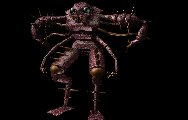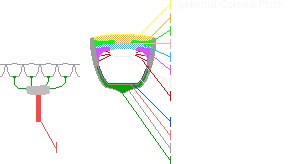


|



|
![]()
Like the Vaipen little is known about the Ovaska in any detail. However
a number of major studies have been published which focus on the Ovaska, who
are not as secretive as the Vaipen. From these it emerges that the Ovaska are
similar in form to the Vaipen, only much heavier of build and with
considerably greater strength.
 All Ovaska who have submitted to study are
under 7 feet tall and their average weight is about 240 pounds. Much of their
body is covered in a thick layer of a bone type substance, the exact
composition and characteristics of which are unknown. All studied Ovaska
have 2 legs and 4 'arms', in addition they also have a number of retractable,
prehensile, tentacle like appendages, between 4 and 6 on average, the function
of which is not known. The Ovaska have at lease 2 brains, situated behind the
eyes and mouthparts, which are divided by an intracranial bone. In addition a
number of nerve ganglia are situated along the spinal column and appear to act
as autonomic reflex centres and primary information processing units.
All Ovaska who have submitted to study are
under 7 feet tall and their average weight is about 240 pounds. Much of their
body is covered in a thick layer of a bone type substance, the exact
composition and characteristics of which are unknown. All studied Ovaska
have 2 legs and 4 'arms', in addition they also have a number of retractable,
prehensile, tentacle like appendages, between 4 and 6 on average, the function
of which is not known. The Ovaska have at lease 2 brains, situated behind the
eyes and mouthparts, which are divided by an intracranial bone. In addition a
number of nerve ganglia are situated along the spinal column and appear to act
as autonomic reflex centres and primary information processing units.
 The Ovaskan visual organs are compound in structure but each 'eyelet' is more
advanced than the human eye in construction: First there is the epidermal
corneal plate under which is the superior aqueous humour. Below these
lie, in order, the contractile diaphragm, inferior aqueous humour, subcutaneous
corneal plate, ciliary body, lens, vitreous humour, retina, reflective
membrane, and finally the sclera. The Ovaskan eye also has no blind spot
as the nerves connecting the sensory cells to the optic nerve all enter a nerve
ganglia behind the compound eye for primary processing before forming a single
nerve bundle. The overall structure of the eye gives much better dark vision than
the human eye and, due to the compound nature of the visual organs, the Ovaska
have much greater visual accuracy and resolution than other races. Their eye
also includes sense organs to pick up visual, infra red and ultraviolet light.
Some amount of bioalteration appears to be prevalent in Ovaskan
society as it is common for Ovaska seen in public to have bioengineered
appendages or alterations to aid them in their tasks. Ovaskan DNA consists of
6 bases rather than the conventional 4. This is assumed to be due to
the environment in which the component amino and nucleic acids formed. The function
of the extra base pair is unknown and research is ongoing. See the section on
exogenetics for more details.
The Ovaskan visual organs are compound in structure but each 'eyelet' is more
advanced than the human eye in construction: First there is the epidermal
corneal plate under which is the superior aqueous humour. Below these
lie, in order, the contractile diaphragm, inferior aqueous humour, subcutaneous
corneal plate, ciliary body, lens, vitreous humour, retina, reflective
membrane, and finally the sclera. The Ovaskan eye also has no blind spot
as the nerves connecting the sensory cells to the optic nerve all enter a nerve
ganglia behind the compound eye for primary processing before forming a single
nerve bundle. The overall structure of the eye gives much better dark vision than
the human eye and, due to the compound nature of the visual organs, the Ovaska
have much greater visual accuracy and resolution than other races. Their eye
also includes sense organs to pick up visual, infra red and ultraviolet light.
Some amount of bioalteration appears to be prevalent in Ovaskan
society as it is common for Ovaska seen in public to have bioengineered
appendages or alterations to aid them in their tasks. Ovaskan DNA consists of
6 bases rather than the conventional 4. This is assumed to be due to
the environment in which the component amino and nucleic acids formed. The function
of the extra base pair is unknown and research is ongoing. See the section on
exogenetics for more details.
All Ovaska have strong/ very strong telepathic abilities but almost none have ever displayed any telekinetic ability. They have been known to use their telepathic ability as a weapon but they do not appear to use it in normal life.
Less is known about Ovaskan society than is known about the Vaipen. Some evidence has suggested that the Ovaska are ruled by a group of 8 elected leaders who rule from the Ovaska homeworld but no confirmation of this has been forthcoming.

The only picture of the Ovaska homeworld, released shortly after the first human/ Ovaska contact is shown here. There has been speculation as to whether this is actually the Ovaska homeworld but it is generally accepted as a valid picture. If it is the Ovaska homeworld it is possible to deduce a few facts. The most striking feature is the cloud density, which has been calculated to be as high as 85% coverage, which covers the planet. The coloration of the clouds suggests atmospheric components like oxygen and hydrocarbon compounds. Negotiations are currently underway to allow Dr Forrester and a small group of assistants to visit the Ovaska homeworld some time in 2261 or 2262.
No Ovaskan writings have ever been found, and no-one has ever heard spoken Ovaska so nothing is known about their language. It is assumed that it is similar in form to Vaipen language but this is by no means certain given the amount of time the two races have had to evolve separately.
The Ovaska have only begun to submit to study in the last 100 years, and of the 8 studies which have been conducted 7 were done/ are being done by Earth scientists. These studies are available on StarNET. Select the name to download the information;
| Date | Source/ Author | Title and notes |
|---|---|---|
| 2160 | Geneva Medical Forum | "Studies of Ovaska biology" |
| 2172 | New London college | "Ovaskan society and political structure" |
| 2173 | Dr T. J. Philips | "Views on Ovaska technology" |
| 2201 | Dr M Forrester | "Exobiology summary: Ovaska" |
| 2204 | M2.I.S.T. | "Ovaska research report" |
| 2210 | J'halm Tarn | "Ovaska: biology and social interaction" Document is incomplete/ censored |
| 2240 | Dr M Forrester | "Ovaskan technology" |
| 2259 | Dr M Forrester | "Origins and evolution" Study is currently ongoing |
Outstanding facts from these studies indicate, like studies of the Vaipen, that the Ovaska have ceased to expand their borders for unknown reasons. It is also apparent that the tensions between the Ovaska and Vaipen are on the increase. Ovaskan technology is almost completely organic, and is discussed in the section on organic technology.
Attempts to investigate Ovaskan life are often blocked by the Ovaska and ships entering Ovaska space are normally turned back or brought back. Unlike the Vaipen, the Ovaska rarely destroy ships entering their space but the reception awaiting anyone who does enter is normally cold and may escalate into violence if the offender does not leave immediately.